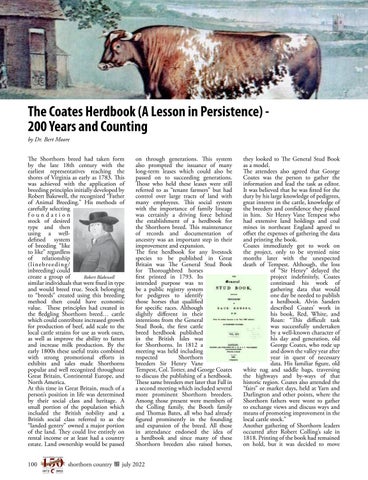The Coates Herdbook (A Lesson in Persistence) 200 Years and Counting by Dr. Bert Moore The Shorthorn breed had taken form by the late 18th century with the earliest representatives reaching the shores of Virginia as early as 1783. This was achieved with the application of breeding principles initially developed by Robert Bakewell, the recognized “Father of Animal Breeding.” His methods of carefully selecting foundation stock of desired type and then using a welldefined system of breeding “like to like” regardless of relationship ( l i n e b re e d i n g / inbreeding) could create a group of Robert Blakewell similar individuals that were fixed in type and would breed true. Stock belonging to “breeds” created using this breeding method then could have economic value. These principles had created in the fledgling Shorthorn breed… cattle which could contribute increased growth for production of beef, add scale to the local cattle strains for use as work oxen, as well as improve the ability to fatten and increase milk production. By the early 1800s these useful traits combined with strong promotional efforts in exhibits and sales made Shorthorns popular and well recognized throughout Great Britain, Continental Europe, and North America. At this time in Great Britain, much of a person’s position in life was determined by their social class and heritage. A small portion of the population which included the British nobility and a British social class referred to as the “landed gentry” owned a major portion of the land. They could live entirely on rental income or at least had a country estate. Land ownership would be passed
on through generations. This system also prompted the issuance of many long-term leases which could also be passed on to succeeding generations. Those who held these leases were still referred to as “tenant farmers” but had control over large tracts of land with many employees. This social system with the importance of family lineage was certainly a driving force behind the establishment of a herdbook for the Shorthorn breed. This maintenance of records and documentation of ancestry was an important step in their improvement and expansion. The first herdbook for any livestock species to be published in Great Britain was The General Stud Book for Thoroughbred horses first printed in 1793. Its intended purpose was to be a public registry system for pedigrees to identify those horses that qualified for specific races. Although slightly different in their intentions from the General Stud Book, the first cattle breed herdbook published in the British Isles was for Shorthorns. In 1812 a meeting was held including respected Shorthorn breeders Sir Henry Vane Tempest, Col. Totter, and George Coates to discuss the publishing of a herdbook. These same breeders met later that Fall in a second meeting which included several more prominent Shorthorn breeders. Among those present were members of the Colling family, the Booth family and Thomas Bates, all who had already figured prominently in the founding and expansion of the breed. All those in attendance endorsed the idea of a herdbook and since many of these Shorthorn breeders also raised horses,
American Shorthorn Association
100
1872
2022
shorthorn country = july 2022
they looked to The General Stud Book as a model. The attendees also agreed that George Coates was the person to gather the information and lead the task as editor. It was believed that he was fitted for the duty by his large knowledge of pedigrees, great interest in the cattle, knowledge of the breeders and confidence they placed in him. Sir Henry Vane Tempest who had extensive land holdings and coal mines in northeast England agreed to offset the expenses of gathering the data and printing the book. Coates immediately got to work on the project, only to be stymied nine months later with the unexpected death of Tempest. Although, the loss of “Sir Henry” delayed the project indefinitely, Coates continued his work of gathering data that would one day be needed to publish a herdbook. Alvin Sanders described Coates’ work in his book, Red, White, and Roan: “This difficult task was successfully undertaken by a well-known character of his day and generation, old George Coates, who rode up and down the valley year after year in quest of necessary data. His familiar figure, old white nag and saddle bags, traversing the highways and by-ways of that historic region. Coates also attended the “fairs” or market days, held at Yarn and Darlington and other points, where the Shorthorn fathers were wont to gather to exchange views and discuss ways and means of promoting improvement in the local cattle stock.” Another gathering of Shorthorn leaders occurred after Robert Colling’s sale in 1818. Printing of the book had remained on hold, but it was decided to move















